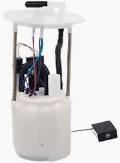The electric fuel pump is a component in its own right, which appeared when the car was developed and equipped with an MPFI system. The electric fuel pump is located in most newer vehicles inside the fuel tank and operates within a specific pressure range of 35–65PSI, based on your engine specifications. The fuel needs to be correctly atomized upon injection into the combustion chamber, which allows for better engine performance and a significant reduction in fuel consumption.
Fuel Pump — The electric fuel pump's main role is to keep the fuel pressure stable across your different driving environments. It runs when the engine is running and as a result sends gas to the fuel injectors at consistent pressures so that you have what right fuel sent around. A failing fuel pump can cause engine misfire, stalling or sluggish acceleration due to lack of adequate fuel pressure. A car needing 50 PSI may perform poorly with even half that pressure if the pump fails to maintain adequate fuel pressure.
The electric pump has a fuel flow regulator which not only normalizes the amount of gas that goes through but adjusts the pressure depending on engine use. This means the engine control unit (ECU) can more accurately regulate how much air and fuel are mixed together, which improves combustion efficiency and keeps emissions to a minimum. Today, electric fuel pumps are a significant advancement over the mechanical units used in older carbureted engines because they function as part of a vehicle's electronic system and provide more precise control over how much fuel is delivered.
Conclusion 12.2 Electric fuel pumps also enhance safety of the fuel system Located in the fuel tank, the pump helps cool down the fuel reducing chances of vapor lock (the point when gas evaporates inside in your line and stalls up). Older vehicles often suffered from a Vapor lock, especially in hot weather conditions with the introduction of electric pumps this problem is greatly reduced.

When a Give Way ClosesObviously, failure of the fuel pump will be most apparent during starting (hard or no), and power-up operation(under acceleration); engine stalling at high-speed is but the last condition encountered. A couple of examples, say a weak electric fuel pump, that can't hold 50 to 60 PSI WOT may intermittently misfire the engine or cause it to stall. The publication reports that in 2019, fuel pump failures were the leading cause of vehicle breakdowns at just above 20%, furthering illustrating how much a car relies on its fuel pump.
Photo: Electric fuel pumps are built to last 100,000-150,000 miles or even more but if the pump is constantly picking up contaminants from dirty gas like seen here (bottom) or heat due running on low fuel for an extended period of time which would cause the pump to overheat.
If you want more information about choosing and replacing a Electric Fuel Pump, visit our site at Model for your exact vehicle needs.